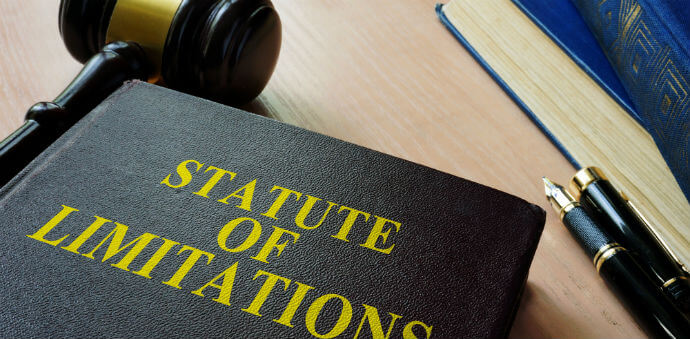Filing a personal injury claim is not one of those decisions you need to ‘mull over’ before acting on it. Failing to act during the personal injury statute of limitations could cause you to lose your rights. Each state has a time limit during which you must file a personal injury claim.
What Is the Statute of Limitations?
The statute of limitations is how long you have to file a lawsuit. If you are in an accident, the clock starts ticking right after the accident occurs. Not only do states have different statutes of limitations, they also differ depending on the type of claim you want to file. For example, California gives you two years from the time of your accident to file a personal injury claim. Thanks to new legislation in October of 2017, California residents now have six years to report a hit-and-run accident instead of the previous three-year period.
The statute of limitations varies from one year up to six years, depending on the state where you live. When filing a personal injury claim, you need to know the personal injury statute of limitations for your state specifically. That might seem like a lot of time, but it isn’t. You need all the time you have available to prepare for your case.
Exceptions to the Statute of Limitations
The Discovery Rule
One exception that might allow you to file a personal injury claim after the legal time limit runs out is the discovery rule. This rule may apply if you weren’t aware of your injury or that it was potentially caused by the other person’s actions until after the time period is up.
In a sense, the discovery rule doesn’t change the statute of limitations. You still have the same time period during which to file your claim. It merely changes the point at which that time period begins. If you are injured in a car accident, the cause of your injury will probably be apparent. Those that occur from exposure and/or occur over time sometimes aren’t apparent for months or even years.
Example of the Discovery Rule
Personal injuries aren’t always caused by another person or entity that you interacted with directly. Sometimes the items you put in your home or office aren’t made correctly or they contain toxic materials.
Suppose you decide to have new carpeting installed in your home. When you go to pick it out, you look at features like color, thickness, and price. There’s no label on the carpet that says, “may contain toxic chemicals.” The problem is that an increasing number of people are getting sick from their carpeting. Still, many don’t consider the connection ‘proven’.
You begin to have severe headaches just weeks after the carpeting is installed. Your toddler, who spends a lot of time in the floor, was just diagnosed with asthma. Months later, you start to have neurological problems including brain fog, dizziness, and muscle spasms. It isn’t until five years after you had the new carpet installed that you learn about the proven link between toxins in carpet and the incidence of neurological and respiratory problems.
The discovery rule allows for you to file a claim against the manufacturer of the carpet once you discover that it is the cause of your injuries. If the personal injury statute of limitations in your state is two years, you will have two years from the time that you learn what caused your injury.
Proving that the company that made your carpet is at-fault for your injury can be challenging. Your attorney will need to collect a great deal of evidence to prove your case. You need to know if others have become ill after having the same brand of carpeting installed. If the manufacturer continued to use the same materials to make the carpet after finding out its effects, it will help you prove their liability. The designer, manufacturer, or retailer may be liable for an injury from a defective product. Your attorney needs the entire time period allowed by the statute of limitations to gather the evidence and prepare your case.
Defendant Out-of-State
The statute of limitations doesn’t apply to time the person who caused your injury is out of the state. This rule applies to personal injury cases in most states, but not all. It can also be difficult to prove. Talk to your personal injury attorney about your specific circumstances and which exceptions might apply.
Age or Mental Capacity of the Injured Party
If the injured party is under the age of 18 years, disabled, mentally ill, or insane, most states will allow the statute of limitations to be extended. In most cases, a parent or legal guardian must file the personal injury claim on behalf of the minor. Cases involving disabilities and/or mental illnesses are handled differently. If the accident contributed to the development of the condition, you and your lawyer will have to prove its cause through evidence, including medical records. If the condition existed prior to the accident, it is considered ‘pre-existing’ and may present challenges to you and your legal team.
Personal injuries include both physical and psychological injuries. They can have a mild to debilitating impact on the victim, sometimes causing depression, anxiety, post-traumatic stress disorder (PTSD), and even personality changes. Your attorney will use the time allotted from the statute of limitations to prove the accident caused your injury and to prove your damages. The other side will use this time to accomplish the opposite.

Preparing for Your Personal Injury Case
One reason that accident victims fail to meet the deadline for filing a personal injury claim is their lack of familiarity with what a personal injury is. Personal injuries are those that occur to you, not your property. They are the fault of another person or entity, either through negligence or a willful act.
Car accidents are the most common cause of personal injuries. They range in severity from minor fender-benders to crashes that cause severe injuries and death. Immediately after a car accident, you’re probably feeling grateful to be alive. Many people are shaky and worried more about the condition of their car than their injuries.
If you check on the other driver and they’re feeling pretty much the same, you might feel inclined to reassure them. You tell them you aren’t hurt and maybe even take some of the blame for the wreck. All of these responses come naturally. They can also ruin your chances of collecting the benefits you need and deserve.
People tend to have a ‘flight or fight’ response to an accident, increasing the levels of adrenaline in their brain. You may feel a rush of energy, a trade-off for the loss of memory that often accompanies it. When you begin to have symptoms of an injury hours or days later, you might not remember how it could have happened.
Never assume that an accident was just that; an accident. Any time two or more vehicles hit, at least one of them did something wrong. Right after the accident is the right time to start collecting the evidence. The timer has just started on the personal injury statute of limitations. You probably don’t even have an attorney in mind. But now is the only chance you will have to take pictures of the scene and get witness information. Don’t question whether it was your fault, the other driver’s, or the kid riding by on a bike. By the time you meet with an attorney, you will have everything you need to decide whether you have a case.

Schedule a Consultation with a Personal Injury Attorney
The initial consultation is the first step in the personal injury claim process. Your choice of an attorney is one of the most important ones you will make. You need someone who has handled many similar cases in your area. Your attorney should also be as successful at negotiating settlements as he is at litigation. Most personal injury cases never make it to court. Make sure you have someone capable and compassionate about getting you the best settlement possible.
The attorney will look at all the evidence you have to evaluate your case. The accident report and all of your medical records are especially important. Also, keep records of any hospitals or medical providers you have seen for which you haven’t received bills. He will use your records and the answers to several questions to determine who is at-fault for the accident and the extent of your damages.
Your attorney will spend time researching the laws related to your case. He will also interview witnesses and learn what statements you’ve made about the accident and your injuries. He will determine your current and potential future medical expenses, loss of wages, and the impact the injury has had on your life.
Even though your personal injury claim isn’t likely to go to court, your attorney must be fully prepared to fight for your rights. If you fail to have a well-planned presentation, the other side will use it to their advantage. You don’t have to wait until the personal injury statute of limitations expires to negotiate a settlement with the other side. This time limit applies only to how long you have to file. Some people wait until the very end of the allotted time as a strategy against the defense. They think that “surprising” the defendant with the claim will give them an advantage.
The statute of limitations gives you time to consider what impact your injuries will have on you in the future. It’s a time to gain knowledge about personal injuries and about your case. Before you file a claim, the numbers and the evidence need to be accurate. Use the time you need to prepare and then file your claim when you’re ready to pursue your case. Sooner is better than later. It’s better to allow plenty of time for unforeseen problems that could invalidate your claim.
Depending on the statute of limitations for your state, waiting to file a claim could mean waiting years longer to get a settlement. If you can’t reach an agreement and the case proceeds to trial, getting a judgment might take months or years.
Personal injury laws are complex and a lot of preparation goes into building a strong case. Whether you have filed a claim or not, the process starts from the day of the accident. However, you should wait until your medical treatment is finished. If you have long-term medical requirements, you want to include them in the claim.
It is in the best interest of both parties to settle your claim before you go to court. This allows you to have control over any agreement that is made. In the courtroom, the decision is in the hands of the judge or jury. You never know what the final decision will be. If it’s one you aren’t happy with, you have the option to appeal. This means more time and money spent without any guarantee of a settlement.
Other Types of Personal Injuries
Car accidents are the most common cause of personal injury but there are many others including:
- Motorcycle Accidents
- Dog Bites
- Slip & Falls
- Burn Injuries
- Product Defects
As long as your injury meets the definition of a personal injury, the same personal injury statute of limitations applies. If another person or entity is responsible for your injury and the resulting damages, they need to compensate you for your losses. Make sure you do everything you need to file your claim quickly and correctly.
An experienced personal injury attorney in your area can help you understand the laws that apply to your claim. He will work as your partner to present a good case that has more than a fair chance of winning.
If you’ve been injured because of someone else’s negligence, contact Batta Fulkerson. We offer a 100% free evaluation of your case. Let us help you start the process of getting the compensation you deserve for your injury.




